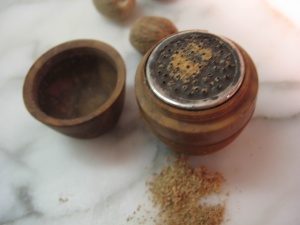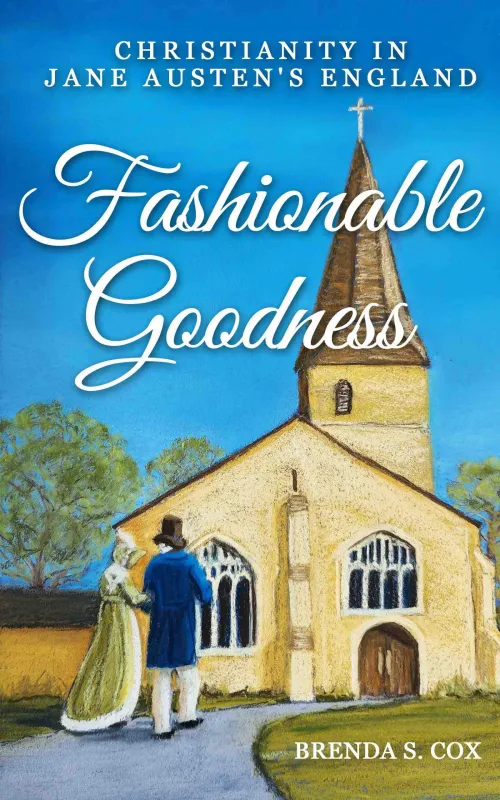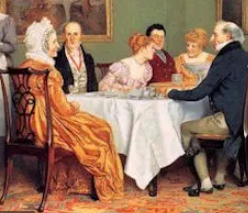Yesterday I came across an interesting description in Ackermann’s Repository of Arts, Literature, Commerce, Manufactures, Fashions, and Politics, April, 1812, about coquilla nuts, which a certain Mr. R. Ackermann displayed at his Repository, No 101, Strand (having purchased a considerable quantity of this fruit).
From whence the Portuguese obtained it, is so little known, that even the botanical library of Sir Joseph Banks cannot ascertain the circumstance. The probable conjecture, however, is, that it is the produce of the Portuguese possessions in Africa. It is, in a great measure, unknown in this country, nor can it be otherwise, as it is near sixty years since the custom-house entries mention an importation of it…”
The coquilla nut is in fact the fruit of the Brazilian Palm, which is closely related to the coconut palm. The nut is 3-4 inches long, and has a very hard, richly streaked brown shell that is capable of taking a fine polish. It is a source of palm oil. The tree also offers up a stiff, wiry leaf fiber that is used for making brooms and rope. Coquilla nuts were routinely converted into a variety of highly ornamental articles:
The uncommonly pleasing colour of the shell, the hardness and the native mottle which appears when it is highly polished, renders it capable of being employed, with the most agreeable effect, as it is susceptible of the most tasteful forms — on the writing-table, in wafer-boxes and seals, pounce, sand-boxes, &c. — on the ladies’ work-table, in needle-cases and thimble-cases, cotton-boxes, pincushions, &c. — or on the toilette and dressing-table, in boxes for lip-salve, rouge, scented sponges, and every kind of pomade. In the form of egg-cups, the nuts will be found to decorate the eating ‘table. As bell-pulls, they are very elegant.

19th c. coquilla nut pomander and nutmeg grater. Image @Christie's.
Coquilla nuts were also made into umbrella handles, candlesticks, and dice cups. The carved product was combined with ivory, or in the case of jewelry, with jade. I could find no examples of jewelry, and wonder it the nut was widely used for such a use.
As they appear to great advantage when worked up into beads, rosaries, and crosses, they will, doubtless, give a pleasing variety to personal decoration, when shaped into necklaces, bracelets, ear-rings, and other trinkets. Little useful pocket articles, as nutmeg-graters, cases for smelling-bottles, and other similar portable conveniences ; in short, whatever has been formed from ivory, may be produced from the shell of the Coquilla, whose beauty will not fail to attract, while the price of the article will satisfy the purchaser.”
Antique coquilla nut items are still quite reasonably priced, as this nutmeg grater from Historic Cookery attests. The Ackermann’s description indicated that the item was carried in the owner’s pocket, in order to season food ordered at a chopping house or club, no doubt.
The most interesting coquilla nut item is this one: a flea trap.
It is easy to forget the squalor, poor hygiene, stench and infestations which our forefathers endured. In the 18th and 19th century flea traps were filled with a few drops of blood and honey or resin, depending on your financial means. Supposedly, fleas attracted by the blood would enter the trap and get stuck to the honey or resin. They were hung around the neck, worn in ladies clothes or kept in bed. – Physick.com
This coquilla nut flask seems a relatively simple item (One wonders how much liquid such a small flask would contain, unless it was whiskey or laudanum, or some other potent substance). Examining it closely, one can read inscribed on its top:
‘In the West Indies, I did grow upon a tree so high a negro come and cut me down a soldger…did me buy.., H. Neal, 35, Royal Sussex’. – Millers Antiques Guide
Some coquilla nut items were larger and more elaborate. One surmises that a series of nut carvings were joined and glued together to create these beautiful candlesticks carved by Indian artisans in Bengal, who worked from designs supplied by locally based European tradesmen.

Late 18th C. Anglo Indian coquilla nut and ivory table candlesticks. Image@Online Galleries: The Antique Portal
…these candlesticks typical of the Murshidabad workshops delicately carved decoration, may have stood on an ivory ‘teapoy’, whose form was directly taken from a European candlestand.” – The Antique Portal
More about the featured items:
- Candlesticks at Online Galleries: The Antique Portal
- Ink stand @Antiques Atlas http://www.antiques-atlas.com/antique/18thcearly_19thc_finely_carved_coquilla_nut/as304a057
- Christie’s Coquilla Nut Pomander and Nutmeg Grater














You do find the most amazing things. Thank you for this.
If the Brazilian Palm is not endangered, modern items made from coquille nut shell would be wonderful – an eco-friendly replacement for plastic buttons, for example!
This reminds me of the many little wooden objet d’art I have from my mother, only they are Japanese. But give an artist anywhere around the world a nice piece of wood and they produce wonderful things. You tend to think the Western world has forgotten this kind of handicraft unless you read woodworking magazines or look at all the cunning things people sell on etsy.com. Thanks for another tangible, tactile link to the past, even though it has been communicated electronically.
Prison this the same palm oil tree that is destroying the forests of Indonesia to provide biofuel?. If so there must be millions of these nuts. Is the whole thing ground to produce oil or are they by products?
Rowena, the coquilla nut is from Brazil. The oil is extracted from the coquilla nut, like coconut oil from the coconut. Today the coquilla nut is still being carved into buttons and other household items.
Fascinating post! I especially like the nutmeg grinder. Thanks for continuing to enrich my understanding of 19th century life, Vic. Much appreciated. :)
Glad somebody brought up the ecology angle.
Always fun to see the objects that were treasured.
This is something I’ve never heard of. An interesting read!
I’ve never heard of them before. How facinating.
Reblogged this on Ella Quinn ~ Author and commented:
From Jan Austen’s Website
Awesome stuff! There certainly was more artistic stuff around in the 18th and 19th century.
At Historic Huguenot Street, we have had a coquilla nut flea trap in our collection and have never known what it was. We thought it was some type of carved decorative piece. Now, thanks to your article, we can talk about this artifact and use it as a piece for discussion.
Fascinating! And quite beautiful. Although the bit about using it as a flea trap made me slightly ill…
[…] because you find out some really weird stuff, like how pretty knickknacks could also be used as flea traps that hung around your […]
Hi Vic, I am investigating a material called ‘Kokka’ (see this blog i found on the Internet: http://www.aksesoris-kayu-kokka.blogspot.com/). Some people said that the Kokka seeds referred to in this website is actually coquilla nut. I wonder if you know if it’s true.
I own over 100 coquilla nut items, and I question the attribution of the item identified by Physick.com as a flea trap. (Interestingly, their link to the “flea trap” is no longer active.) There are numerous coquilla items with similar pierced designs, and this egg shaped box is one of the most common. I also own a true antique flea trap, which is cylindrical in shape, and from an earlier period. It is the subject of a 1975 article in Smithsonian magazine. Based on how these worked and were used, the egg shape does not make sense. (It is more likely a pomander.) I would be interested to see any factual evidence of the claim that these egg-shaped coquillas are flea traps. I’m concerned that they are showing up on Ebay and other places with this possibly erroneous attribution.
I have many pieces of coquille nuts .I am wondering is there any books detailing the process of making these nuts in to fine pieces of art ,also any background info on where they where made. I have many pieces and many questions about them .Thanks